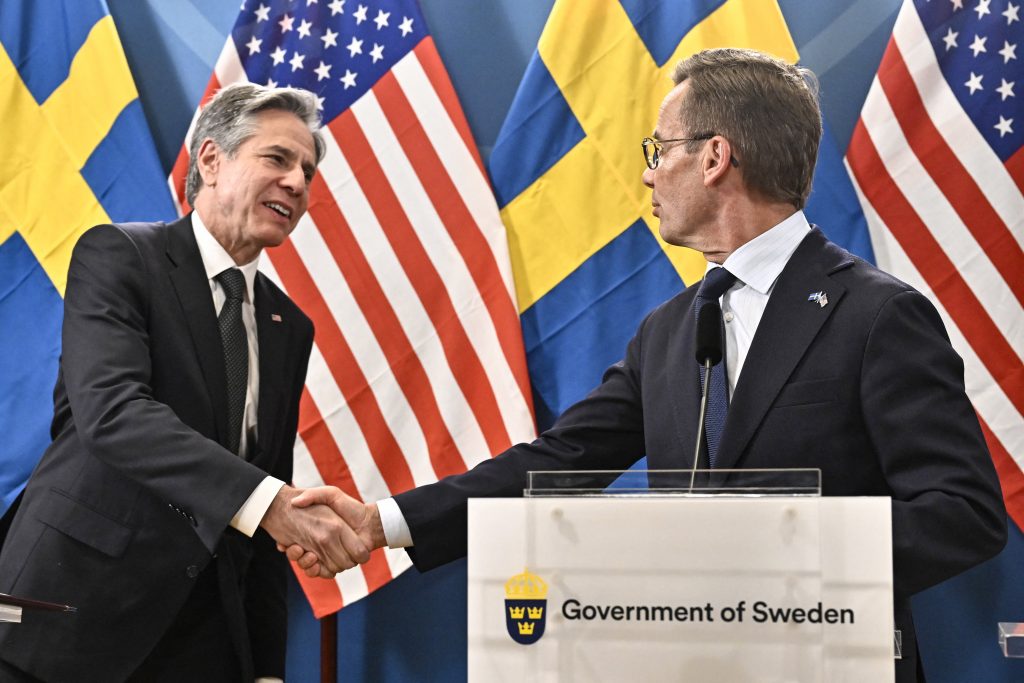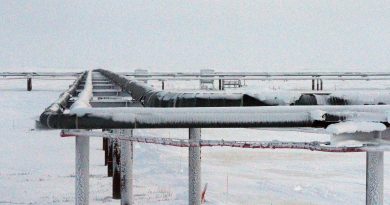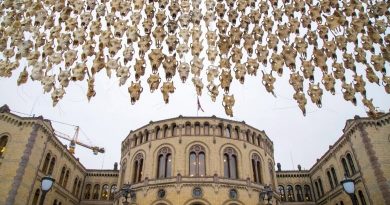Blog: Blinken touts Arctic green transition as fighter jets rumble overhead

The discovery of rare earth elements at the world’s largest underground iron ore mine in Kiruna promises to fuel the green transition. They may also provide strategic materials to bolster Western dominance over the Arctic’s skies.
Foreign ministers usually conduct international affairs from the hallowed halls of national capitals. But two weeks ago, U.S. Secretary of State Anthony Blinken turned up in the sub-Arctic Swedish coastal city of Luleå: population 78,000, latitude 65°N – a smidge below the Arctic Circle.
During the first stop on his Nordic tour, which took him to Sweden, Norway, and Finland, Blinken visited the Luleå Air Base, Norrbotten Wing (F 21), where he met with Swedish Prime Minister Ulf Kristersson and Swedish Foreign Minister Billström. Kristersson opened the press conference (for which the full video and transcript are available online) by describing:
“Right now, we are, as we all know, at F 21, an air force wing in northern Sweden, and while we are here, the Arctic Challenge Exercise, the ACE, is taking place at F 21 as well. Both Swedish-made Gripen fighters and American-made F-16s can be seen operating in the air during the ACE. The north of Sweden is geographically very important for the Swedish armed forces as it provides strategic depth for us and for our neighboring countries. The Russian border is actually a six-and-a-half-hour drive from here. Filling the territorial gap in the north will be one of Sweden’s many security contributions to NATO when we join the Alliance.”
The fighter jets that are filling the skies to fill in the “territorial gap” could be heard on full tilt from down below, as videos such as the below on Twitter testify. The ACE, which has taken place since 2013, only just wrapped up, having run from May 29 through June 9.
Ingen bra plats, men det blev det som det blev. pic.twitter.com/yNYQOK5bzv
— Johan 🇸🇪 🇧🇷 (@Tingan_sabia) June 6, 2023
Blasting the Earth to blast through the skies
Maintaining dominance over the Arctic not only requires filling the skies above with high-flying bits of metal, but hollowing out the Earth below.
In Luleå, the day after visiting Norbotten Wing, Blinken co-chaired a meeting of the European Union-U.S. Trade and Technology Council meeting. During the press conference, Kristersson explained that the multilateral meeting would “focus on how to ensure that new and emerging technologies – as you heard from the prime minister – like AI, like quantum, like 6G enhance our competitive edge, benefit our citizens, and uphold democratic principles.” In a discursive sleight of hand, the Swedish prime minister turned technologies of the future into guardians of liberal political values – and, implicitly, the liberal international order.
As Sweden is currently President of the Council of the EU, the country took the opportunity to shine the spotlight on Luleå, where a breakthrough technological development is taking place. At the HYBRIT site, the Swedish companies SSAB (a steelmaker), LKAB (the state-owned operator of the world’s largest underground iron ore mine in Kiruna), and Vattenfall (a state-owned power generator) are attempting to revolutionize the steel industry. In their words, they endeavor to “create a completely fossil-free value chain from mine to finished steel, with fossil-free pellets, fossil-free electricity and hydrogen.”
‘Bright future as a mining nation’
One of HYBRIT’s biggest selling points is that it would help eliminate 10% of Sweden’s annual carbon dioxide emissions. A less advertised feature is its plan to construct a new apatite plant, which will enable the separation from apatite concentrate of phosphorus, used in fertilizer, and rare earth metals, used in everything from wind turbines to electric vehicles and fighter jets.
In the press conference with Blinken, Kristersson observed, “In January this year, it was announced that Europe’s largest deposit for rare earth metals is in Kiruna, just some 350 kilometers from here. That’s pretty close, if you ask the locals. And it shows that Sweden has a bright future as a mining nation – increasingly important, again, for the green transition.”
What Kristersson didn’t make explicit is the Swedish Arctic’s importance for maintaining the Western lead on the technologies of the future that are sold as protecting liberal values while being key to protecting NATO territories and market economies. When LKAB announced in January of this year its discovery of a million tons of rare earth oxides at the Per Geijer deposit near its iron ore mine in Kiruna (just five days before the Swedish municipality opened Europe’s first commercial spaceport), some 350 kilometers northwest of Luleå, Jan Moström, President and Group CEO, expressed, “Without mines, there can be no electric vehicles.”
Yet without mines, there can be no fighter jets, either.
American F-35 fighter jets, which are more capable planes than F-16s and which are participating in the Arctic Challenge Exercise for the second time ever this year, each contain 920 pounds of yttrium, terbium, and other rare earth elements, according to Air & Space Forces Magazine. Certain rare earths, such as neodymium, have enormous magnetic properties, making them crucial for the operation of missile guidance systems, antimissile defenses, satellites, and communication systems. While LKAB does not seem to have released specific details regarding what types of rare earth oxides it has identified, it is inevitable that they will bear military relevance. Metals dug out from the Swedish Arctic could therefore one day end up in the planes defending the skies above it.
Swedish prize, Sámi peril
While the rumblings of geopolitical supremacy hurtle through the skies, they begin deep in the blackened maws of Kiruna, the world’s largest underground iron mine. At the beginning of the 20th century, Sámi reindeer schlepped ores across the tundra from Kiruna’s underbelly. In the middle of the 21st, fighter jets may somersault through the clouds and lock onto targets with rare earths dug out of the mine’s fissures.
After Blinken’s visit to HYBRIT, he tweeted how the site is leading the way on the clean energy transition. If he wanted to say the quiet part out loud, he would have emphasized how the site also promises to lead the way in the West’s quest to maintain hegemony over Russia and China.
In Luleå, I visited HYBRIT, a site developing the world’s first low-carbon steel and leading the way on the clean energy transition. @hybrit_project‘s near zero-emissions steel is helping reduce Sweden’s total carbon dioxide emissions and paving the way for change. pic.twitter.com/qa203wIP3X
— Secretary Antony Blinken (@SecBlinken) May 30, 2023
As Sweden’s Minister for Energy, Business, and Industry Ebba Busch (who strolled with Blinken during his visit to HYBRIT, as pictured in his tweet above), stressed at the LKAB press conference announcing its rare earth elements treasure trove in January 2023: “Europe needs to learn the lesson from where we were so highly dependent on one single country for gas in the way we were of Russia. This is why it’s so important that we need to see that literally, Sweden is literally a gold mine – although we’re talking about REEs.”
And so it begins again: the enclosure, both rhetorical and actual, of the Arctic into a mining and military frontier at the expense of other futures. Matti Blind-Berg, chairman of the Swedish Sámi Association, complained to Swedish newspaper Syre that they were only told about the rare earth find the night before it was announced to the world, which he argued violated the United Nations’ principle of free, prior, and informed consent. Developing the Per Geijer deposit, which Swedish officials are framing as urgent and inevitable, risks cutting the Gabna Sami village in two, impeding the spring and autumn reindeer migrations.
Blind-Berg criticized: “The problem is that the Sami village does not have a single opportunity in the world to counter the course of events. One is exposed to enormous pressure from the industry, local society and Sweden in general. Now the Sami village suddenly appears as the party that is against the green transition but if there are any who are affected by climate change and in need of a green transition, it is us natural people.”
This post first appeared on Cryopolitics, an Arctic News and Analysis blog.
Related stories from around the North:
Canada: U.S. report claims Trudeau told NATO Canada will never meet military spending target, CBC News
China: Satellite imagery reveals construction progress on new Chinese Antarctic base, Eye on the Arctic
Finland: Russian cyber attacks, espionage pose growing threat to Finnish national security, Yle news
Greenland: Growing focus on Arctic puts Greenland at higher risk of cyber attacks: assessment, Eye on the Arctic
Iceland: Iceland authorizes U.S. submarine service visits, Eye on the Arct
Norway: Expelled ‘diplomats’ left Norway via Kirkenes and Istanbul, The Independent Barents Observer
Russia: Russian Arctic rescue exercise attended by observers from Iran and Saudi Arabia, The Independent Barents Observer
Sweden: Russian spy ships surveying Nordic energy infrastructure, Radio Sweden
United States: U.S. nominates Alaskan as first Arctic ambassador, Eye on the Arctic




